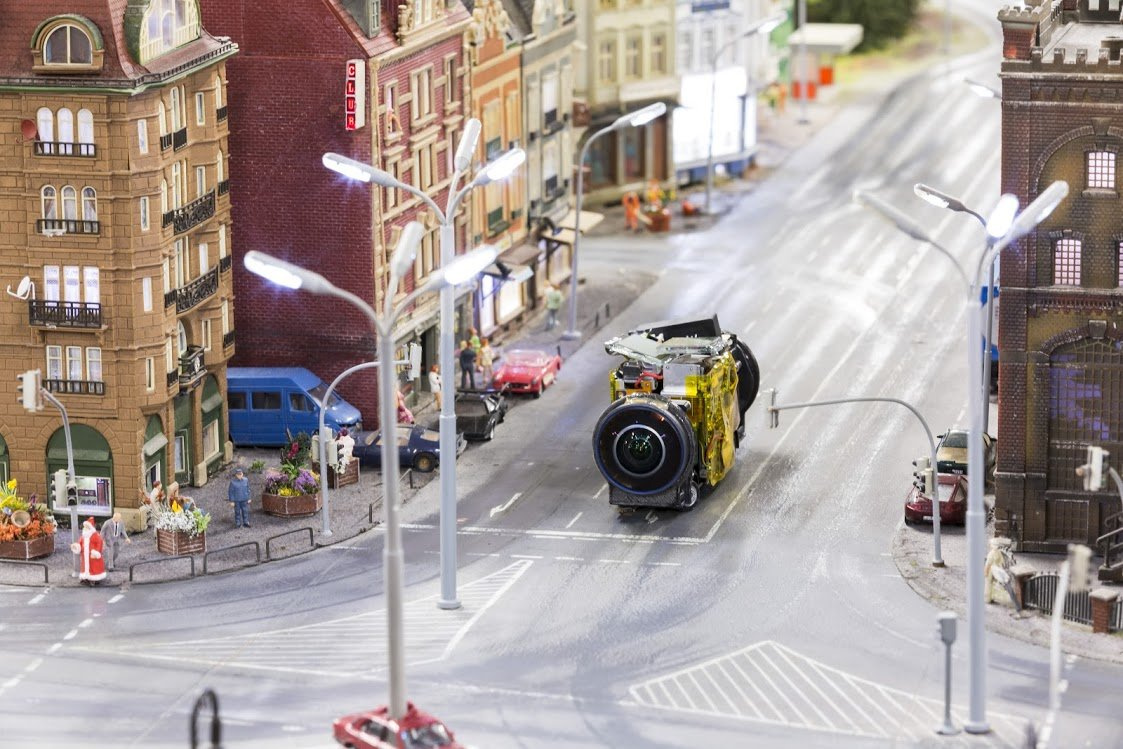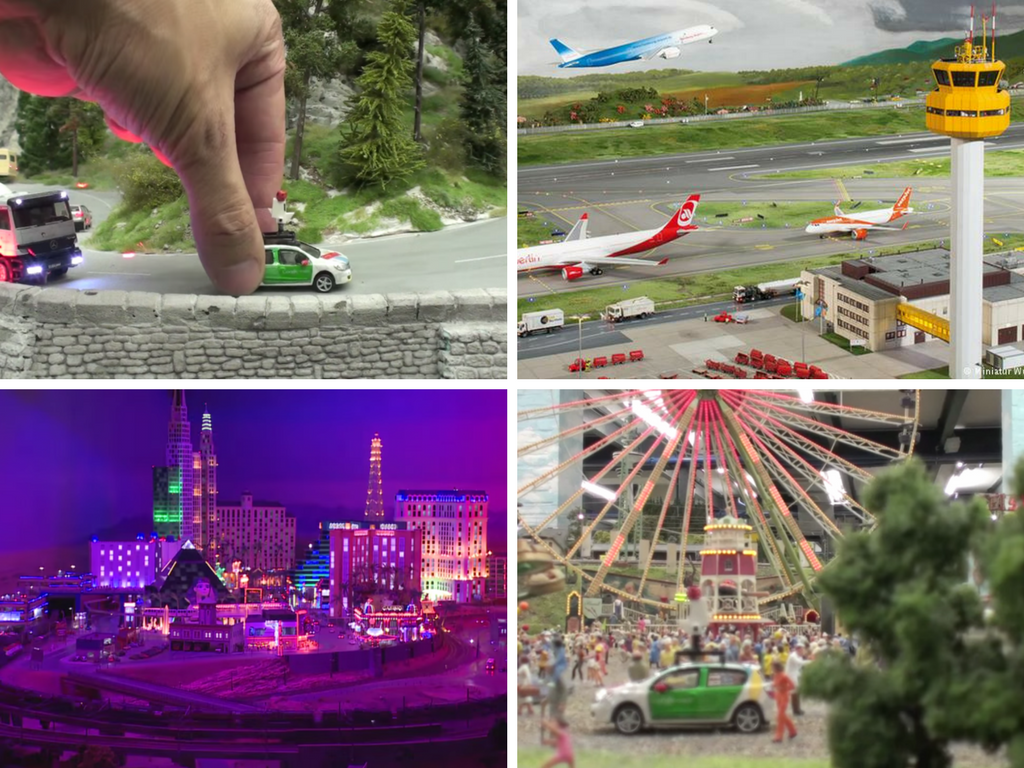Google Street View in miniature: how mini technologies work in the mini world
The parcel post tells how Google makes Street View - in the big world, and in the small one. The company made a version of the panoramas for the largest city of miniatures (with an area of 1300 m2, with a road length of more than 13 thousand km, with 215,000 “inhabitants”). Here's how they got it →

Street View (“ Street View ”) is owned by Larry Page, one of the founders of Google. It all started with the fact that he just filmed a couple of streets of Stanford on his own camera, and then rushed. The project was developed jointly with Stanford researchers and launched in May 2007. Now 65 countries of the world are already in the coverage area - and the guys are obviously not going to stop.
Google Street View is based on 3D scanning technology. Fifteen cameras shoot everything happening on the streets, and three laser scanners help to make three-dimensional models of objects. Most of the equipment is fixed on the roof of the car at a height of about 2.5 meters. If you meet one on the street of your city, you will not know:
Cameras designed specifically for the project use CMOS image sensors and an electronic shutter, so the shooting process itself is simply nowhere to be done - the driver just drives along the route and, when necessary, presses a button. Scanners at the same time also do their job - with their help, the system receives information about the distance of the object.
All data is recorded on SSD-drives. On board the car, they are the most standard, with a total volume of 50-100 TB. This is enough for about a week of shooting: the average city building “weighs” 2-3 GB, and during the day the cameras manage to capture data for 50-100 gigs. Although it all depends on the population of the city - for example, almost 800 GB is spent on one day of recording in New York!

When the material is filmed, it falls into the hands of engineers. They overwrite people's faces and license plates (not themselves, of course, but with the help of special algorithms), make full-fledged panoramas from several pictures and check geotags. However, sometimes the system fails - it turns out pretty funny .

In addition to conventional cars, other vehicles are used for filming: snowmobiles survey ski resorts, cycle rides go where cars do not sneak in (for example, the narrow streets of European cities, university campuses, zoos and even Stonehenge), carts are used for recording in museums , in stadiums and in the White House. Well, in places completely impassable (such as the rocks of the Grand Canyon) comes to the aid of the tracker - a portable system that is fixed on the back of a person.
Now we are getting to the most interesting. A year ago, Google made a smaller version of its Street View-car and launched it in the Miniatur Wunderland in Hamburg - the most famous and largest railway layout in the world. This layout looks very cool, see for yourself:
Last year, the Miniatur Wunderland won the first place in the ranking of attractions of the German National Committee for Tourism (DZT). A huge layout of miniatures began to create 16 years ago from parts of Austria, Germany and the fictional city of Knuffingen. Now in the “world of wonders” 8 states are represented, on which 1000 trains constantly run. There is the Grand Canyon and Las Vegas (USA), the Swiss Alps, Scandinavian snow and glaciers, an amusement park, and even its own airport, from where airplanes fly incessantly. Day and night in the wizarding world change each other every 20 minutes. To create such effects throughout the exposure uses 385 thousand LEDs. It took more than 500,000 working hours to create the largest miniature world. And then Google came and took all this beauty into their panoramas.
Google and the company Ubilabs , specializing in the development of software for interactive maps, have designed a new mini-device for shooting panoramas and fixed it on tiny cars and trains that ride the “Miniature Wonderland”. Now, with the help of a unique technology, you can look into the most remote corners of this layout - and at the same time travel around our miniature world. Here, for example, the streets of the old German city . And right there nearby celebrate noisy Oktoberfest .


But the American views: the Grand Canyon Valley , the night lights of Las Vegas , Mount Rushmore with the faces of four great presidents ... It’s a pity there are no countless American shops and famous department stores on the layout, although why look at them? It is better to go directly to the sites and not to stare, but to buy and save. This is exactly what Banderolk is needed for - a service that helps deliver parcels from the USA and Europe. By the way, you can also make an order from the Google store, and then deliver the gadgets to your home at a 7% discount . However, it is better to check the notification before buying.


Street View (“ Street View ”) is owned by Larry Page, one of the founders of Google. It all started with the fact that he just filmed a couple of streets of Stanford on his own camera, and then rushed. The project was developed jointly with Stanford researchers and launched in May 2007. Now 65 countries of the world are already in the coverage area - and the guys are obviously not going to stop.
How it works?
Google Street View is based on 3D scanning technology. Fifteen cameras shoot everything happening on the streets, and three laser scanners help to make three-dimensional models of objects. Most of the equipment is fixed on the roof of the car at a height of about 2.5 meters. If you meet one on the street of your city, you will not know:
Cameras designed specifically for the project use CMOS image sensors and an electronic shutter, so the shooting process itself is simply nowhere to be done - the driver just drives along the route and, when necessary, presses a button. Scanners at the same time also do their job - with their help, the system receives information about the distance of the object.
All data is recorded on SSD-drives. On board the car, they are the most standard, with a total volume of 50-100 TB. This is enough for about a week of shooting: the average city building “weighs” 2-3 GB, and during the day the cameras manage to capture data for 50-100 gigs. Although it all depends on the population of the city - for example, almost 800 GB is spent on one day of recording in New York!

When the material is filmed, it falls into the hands of engineers. They overwrite people's faces and license plates (not themselves, of course, but with the help of special algorithms), make full-fledged panoramas from several pictures and check geotags. However, sometimes the system fails - it turns out pretty funny .

In addition to conventional cars, other vehicles are used for filming: snowmobiles survey ski resorts, cycle rides go where cars do not sneak in (for example, the narrow streets of European cities, university campuses, zoos and even Stonehenge), carts are used for recording in museums , in stadiums and in the White House. Well, in places completely impassable (such as the rocks of the Grand Canyon) comes to the aid of the tracker - a portable system that is fixed on the back of a person.
And what was there about the mini?
Now we are getting to the most interesting. A year ago, Google made a smaller version of its Street View-car and launched it in the Miniatur Wunderland in Hamburg - the most famous and largest railway layout in the world. This layout looks very cool, see for yourself:
Last year, the Miniatur Wunderland won the first place in the ranking of attractions of the German National Committee for Tourism (DZT). A huge layout of miniatures began to create 16 years ago from parts of Austria, Germany and the fictional city of Knuffingen. Now in the “world of wonders” 8 states are represented, on which 1000 trains constantly run. There is the Grand Canyon and Las Vegas (USA), the Swiss Alps, Scandinavian snow and glaciers, an amusement park, and even its own airport, from where airplanes fly incessantly. Day and night in the wizarding world change each other every 20 minutes. To create such effects throughout the exposure uses 385 thousand LEDs. It took more than 500,000 working hours to create the largest miniature world. And then Google came and took all this beauty into their panoramas.
Google and the company Ubilabs , specializing in the development of software for interactive maps, have designed a new mini-device for shooting panoramas and fixed it on tiny cars and trains that ride the “Miniature Wonderland”. Now, with the help of a unique technology, you can look into the most remote corners of this layout - and at the same time travel around our miniature world. Here, for example, the streets of the old German city . And right there nearby celebrate noisy Oktoberfest .


But the American views: the Grand Canyon Valley , the night lights of Las Vegas , Mount Rushmore with the faces of four great presidents ... It’s a pity there are no countless American shops and famous department stores on the layout, although why look at them? It is better to go directly to the sites and not to stare, but to buy and save. This is exactly what Banderolk is needed for - a service that helps deliver parcels from the USA and Europe. By the way, you can also make an order from the Google store, and then deliver the gadgets to your home at a 7% discount . However, it is better to check the notification before buying.

All Articles